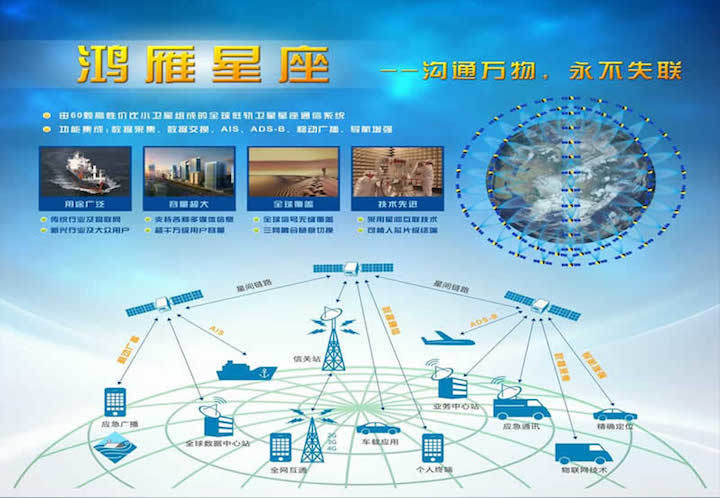
The first Kuaizhou-1A lifts off from the Gobi Desert at 04:11pm UTC on January 9, 2017.
1.03.2018

Potential uses of the 300-satellite Hongyan constellation. CASC
-
China's main government space contractor is moving forward with plans to build a constellation of 300 small satellites in low Earth orbit for global communications and other services.
The China Aerospace Science and Technology Corporation (CASC) announced the updated plan for the expansive constellation last week, with the first satellite to be orbited later this year.
The Hongyan constellation will be composed of more than 300 satellites, along with data processing centres, and will be built in three stages, according to state news Xinhua.
2018 will see the trialling of terminals and verification of the satellite monitoring and control system. No details on the size and capabilities of the satellites nor launch schedule have yet been released.
Once completed around 2021, the Hongyan satellite communication network will take the place of the ground-based network and allow a mobile phone to be connected everywhere on the planet, either in a remote desert or at sea, according to the terse release.
Hongyan translates as 'wild goose'. In ancient China, geese were used to deliver messages, leading to the the idiom, '鴻雁傳書', literally, "a wild goose delivers a message," which also features in famous stories.
A previous announcement of plans for the Hongyan satellite system, in late 2016, noted 60 small satellites with 20 ground stations around the world.
Sun Weigang, chief engineer at CASC, said at the time that the system will provide a wide range of civilian services such as ground data collection and exchange, ship identification and tracking, mobile broadcasting as well as navigation signal enhancement, benefiting many sectors, including marine industries, weather forecasting, transportation, environmental protection, geological survey and disaster prevention and relief.
The expansion from 60 to 300 satellites may be in part explained by a deal with Thailand Kasetsart University, with a memorandum of understandingsigned between the university and an affiliate to the China Great Wall Industry Corp, a CASC subsidiary.
The deal covers satellite construction, ground infrastructure and other areas, and building micro-satellite research and development capabilities for the Thai side, in line with the Thailand 4.0 national strategy. According to the MOU, CASC is open to further cooperation with other companies and countries and around the world.
CASIC, a state-owned 'sister' company to CASC and the country's main missile maker, has its own plans for a narrow-band commercial communications constellation in LEO, dubbed Xingyun, for Internet of Things (IoT).
The Xingyun, or cloud, plan envisages a network of 156 mini-satellites orbiting at around 1,000 kilometres above the Earth, and is slated to be completed by the end of 2025.
CASIC is turning its missile expertise into producing low-cost solid-propellant launch vehicles, named Kuaizhou, while also exploring an expansion into the satellite sector. A first test satellite for Xingyun was launched in January 2017.

The first Kuaizhou-1A lifts off from the Gobi Desert at 04:11pm UTC on January 9, 2017.
Communications satellites have long been large satellites sent to geosynchronous orbit at around 36,000 km above the Earth, operating for around 15 years.
Despite increasing throughput, a number of companies around the world are looking to build LEO constellations of smaller, cheaper satellites in much lower orbits to provide internet access.
These include OneWeb, SpaceX, O3b, Iridium, Telesat Canada, LeoSat and Boeing. The proliferation of such plans of 'mega-constellations', each consisting of hundreds or even thousands of small satellites, is intensifying serious concern regarding orbital debris or 'space junk', which could lead to unintended collisions and further debris.
Even the smallest piece of debris, travelling at several kilometres per second, would pose a serious threat to other spacecraft.
The International Space Station frequently needs to alter its orbit in order to avoid potential collisions.

The International Space Station orbiting above the Earth.